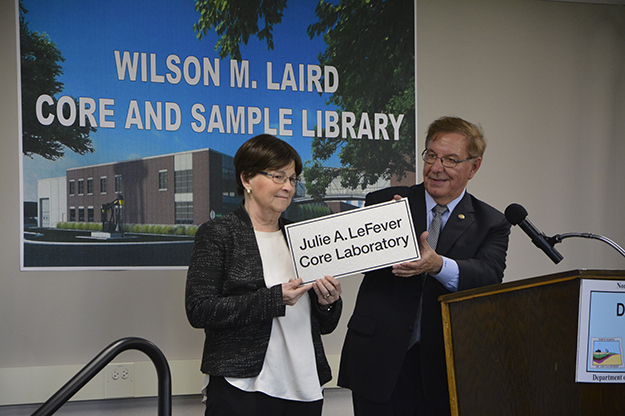Largely unknown legacy of Julie LeFever
Longtime North Dakota geologist, based at UND, posthumously honored for wealth of knowledge that helped Bakken boom

When Julie LeFever spoke, people listened.
She gave talks to standing-room-only crowds about North Dakota drilling core samples and oil development at national conferences. Geologists from oil companies across the nation flew to Grand Forks to visit with LeFever and hear her opinions about core samples and drilling sites. Landowners came to see if there might be oil on their land. Oil executives made drilling investments after visiting with her. And students learned about geology and core samples, later becoming experts in the oil industry.
“Everyone always wanted to talk to Julie,” said Kent Hollands, engineering technologist at the Laird Core and Sample Library. “People came from all over the country, even Germany and Australia, to talk to her. When she went to a conference, everyone tried to talk to her. She was a wealth of knowledge.”
LeFever, who died Dec. 5, directed the North Dakota Geological Survey’s Wilson M. Laird Core and Sample Library on campus for 28 years. Her dedication to preserving and examining core samples from drilling sites in western North Dakota led, many said, to the Bakken oil boom.
“Julie knew where the oil was,” said Hollands. “She looked at nearly every Bakken core, logged it, and put that information together. She knew it was there before the technology existed to extract it.”
Rewarding work
LeFever will receive the Robert R. Berg Outstanding Research Award posthumously this week from the American Association of Petroleum Geologists at a ceremony in Houston. It will be the second major award she received from the organization.
LeFever had an eye on the future, working to study and preserve core samples from drill cuttings. Those samples – 4.4 million tons of rock and counting – can reveal whether or not an area contains oil.
The library, which contains the most complete set of cores and samples in the nation, had nearly reached capacity when the 2015 North Dakota Legislature, recognizing its importance, authorized a $13.6 million expansion that added 28,000 square feet and three additional laboratories. One of the laboratories was named after her during the dedication of the building in September. She was surprised – and thrilled.
“Julie was the face of the core library,” said Richard LeFever, her husband and professor emeritus of Geology and Geological Engineering. “The oil industry has a very high opinion of her.” He added that Harold Hamm, CEO of Continental Resources, for whom the Harold Hamm School of Geology and Geological Engineering is named, was impressed by the core library, but even more impressed by Julie.
“She bent over backward to make it easy for people to do their work there,” said Richard LeFever. “And she was helpful to every graduate student working on core. She liked explaining and showing core.”

“Miss Bakken”
Her work earned her the nickname of “Miss Bakken” among those working in the Williston Basin.
“The students, professors, scientists and engineers who came through the core library in the last 27 years learned things directly from her as well as from the publications that she authored or co-authored on the oil-bearing rocks in the Williston Basin,” said Ed Murphy, State Geologist with the North Dakota Geological Survey.
LeFever wrote her first paper on the Bakken Formation in 1990 and continued writing throughout her career, with more than 150 papers, articles, posters and maps. Some were collaborations with husband Richard or other co-authors.
She will be remembered for sharing her work, published and unpublished. “Countless industry geologists, professors and graduate students benefited from Julie’s spontaneous, one-on-one core workshops in the core library,” said Murphy.
“She was a ‘go-to’ person,” said Hollands. “She was one of the best team players I’ve ever seen.” He said she was often head-hunted by industry, but loved her job. “People would just make her offers,” Hollands said, “but it wasn’t about the money.”
“Julie didn’t have a private face,” said Richard LeFever. “She was the same at home as she was at work. She was great with people, very thorough, and fussy about getting things right.”
“Julie was a great role model and a person to rely on,” said Hesham El-Rewini, dean of the college of Engineering & Mines. “She was always there for our students, faculty, and researchers when they needed help with the resources in the core library. We will miss her knowledge, dedication, and wonderful character.”
“Julie was an incredibly dedicated employee,” said Lynn Helms, director of the North Dakota Department of Mineral Resources. “She put in whatever hours necessary to promote the oil and gas resources of the state. Her reputation and the core library are so intertwined. The recent expansion of the core library is in large part a result of that. There is a tremendous amount of respect from the Legislature and from industry for the work that went on there. Julie’s contributions to the state will live on through her work, and she will truly be missed.”


